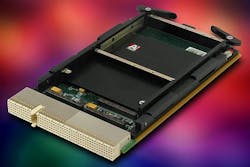DO-178 rugged single-board computer for avionics applications introduced by Aitech
The computer board for safety-critical avionics typically dissipates less than 5 Watts of power to help designers reduce engineering resources typically diverted to RTCA design requirements, Aitech officials say.
The super-low-power embedded computing board is for flight- and mission-control computers in avionics subsystems destined for FAA-controlled airspace. The board also can help designers keep the use of on-board field-programmable gate arrays (FPGAs) to a minimum, company officials say.
"Designed specifically for avionics, our C920 is already safety certified for a major helicopter mission computer application," says Doug Patterson, Aitech's vice president of sales and marketing.
With increased processing power without the added overhead of additional heat generation, the C920 incorporates a integrated PowerQUICC II 8349E processor that is hardware-preconfigured to 400 MHz, ensuring the right mix of high processor horsepower and low power dissipation. The processor also has an on-chip 32-kilobyte instruction and a 32-kilobyte data L1 cache that support a e300 core.
The C920's on-board memory consists of as much as 256 MB fast DDR2 266 SDRAM with ECC protection for exceptional data integrity, 128 megabytes of boot Flash, 256 megabytes of user Flash and 512 KB NVRAM implemented with a fast MRAM (magneto-resistive RAM) for fast read/write storage of critical mission and key board parameters as well as user data storage.
MRAM's unlimited write/erase capacity prevents it from wearing out-a problem associated with other Flash or SSD technologies-increasing the board's long-term reliability.
The C920's 3U form factor accommodates a wide range of integrated I/O including two 10/100 BaseT Ethernet ports and two RS-232/-422/-485 serial ports.
To control real-world systems, the rugged embedded computing board also provides 21 single-ended general-purpose TTL discrete I/O lines, where each line is independently user-programmable as either an input or output and able to generate a processor interrupt on a change of state.
An industry standard PMC slot, compliant to ANSI/IEEE 1386 and ANSI/VITA 20, enables expanded board resources or I/O functionality via standardized mezzanine modules. I/O from the mezzanine is brought out to either the front panel for air-cooled versions or routed to the CompactPCI backplane for conduction-cooled modules.
In a subsystem, the C920 can function as a system controller, supporting as many as five additional cards on the CompactPCI backplane to provide clock, arbitration and interrupt capabilities, or it can serve as a peripheral or "slave" board.
System support devices include an avionics-style, windowed watchdog timer, four 32-bit (or eight 16-bit) timers, and Real Time Clock (RTC). The watchdog timer can be set to either generate a non-maskable interrupt or a board reset.
The standard board support package (BSP) is available for Wind River VxWorks, with a BSP available for Wind River ARINC653 or Green Hills Integrity. The COTS board is available in air or conduction cooling.
For more information contact Aitech online at www.rugged.com.
